Immuno-biosensor on a chip: a self-powered microfluidic-based electrochemical biosensing platform for point-of-care quantification of proteins†
Abstract
The realization of true point-of-care (PoC) systems profoundly relies on integrating the bioanalytical assays into “on-chip” fluid handing platforms, with autonomous performance, reproducible functionality, and capacity in scalable production. Specifically for electrochemical immuno-biosensing, the complexity of the procedure used for ultrasensitive protein detection using screen-printed biosensors necessitates a lab-centralized practice, hindering the path towards near-patient use. This work develops a self-powered microfluidic chip that automates the entire assay of electrochemical immuno-biosensing, enabling controlled and sequential delivery of the biofluid sample and the sensing reagents to the surface of the embedded electrochemical biosensor. Without any need for active fluid handling, this novel sample-to-result testing kit offers antibody–antigen immunoreaction within 15 min followed by the subsequent automatic washing, redox probe delivery, and electrochemical signal recording. The redox molecules ([Fe(CN)6]3−/4−) are pre-soaked and dried in fiber and embedded inside the chip. The dimensions of the fluidic design and the parameters of the electrochemical bioassay are optimized to warrant a consistent and reproducible performance of the autonomous sensing device. The uniform diffusion of the dried redox into the injected solution and its controlled delivery onto the biosensor are modeled via a two-phase flow computational fluid dynamics simulation, determining the suitable time for electrochemical signal measurement from the biosensor. The microfluidic chip performs well with both water-based fluids and human plasma with the optimized sample volume to offer a proof-of-concept ultrasensitive biosensing of SARS-CoV-2 nucleocapsid proteins spiked in phosphate buffer saline within 15 min. The on-chip N-protein biosensing demonstrates a linear detection range of 10 to 1000 pg mL−1 with a limit of detection of 3.1 pg mL−1. This is the first self-powered microfluidic-integrated electrochemical immuno-biosensor that promises quantitative and ultrasensitive PoC biosensing. Once it is modified for its design and dimensions, it can be further used for autonomous detection of one or multiple proteins in diverse biofluid samples.

- This article is part of the themed collection: Miniaturised Sensors & Diagnostics


 Please wait while we load your content...
Please wait while we load your content...